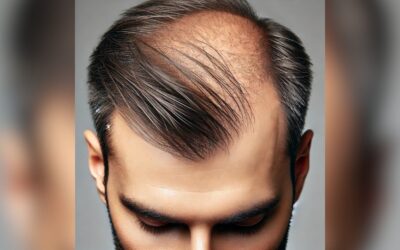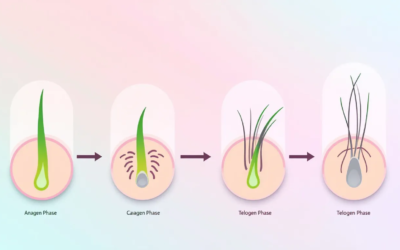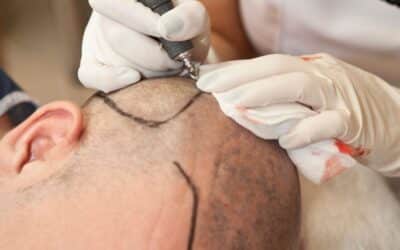One such solution is FUE hair transplantation – an innovative procedure that has revolutionized the world of hair restoration. But who invented FUE hair transplant procedures?
In this blog post, we explore this question and more as we take a closer look at the history of FUE Hair Transplant and its cost considerations when seeking out a qualified surgeon for your procedure.
So if you’re looking for answers on who invented FUE hair transplant procedures or want to know what goes into getting one done, then keep reading.
Table of Contents:
- What is FUE Hair Transplant?
- Who Invented FUE Hair Transplant?
- How Does FUE Hair Transplant Work?
- Cost Considerations for FUE Hair Transplants
- Finding a Qualified Surgeon for Your FUE Procedure
- FAQs in Relation to Who Invented Fue Hair Transplant?
- Conclusion
What is FUE Hair Transplant?
FUE Hair Transplant is a type of hair restoration procedure that uses individual follicular units, or grafts, to restore lost hair. The process involves extracting healthy hairs from the donor area and transplanting them into the recipient area where baldness has occurred.
FUE stands for “follicular unit extraction” and it is considered one of the most advanced techniques in modern hair restoration surgery.
Definition of FUE Hair Transplant:
FUE Hair Transplant is a minimally invasive surgical technique used to restore lost or thinning hair by harvesting individual follicles from an area with thicker growth (donor site) and transplanting them into areas affected by baldness (recipient site).
It does not involve any incisions or stitches, making it less painful than traditional strip-harvesting methods.
FUE hair transplants provide the advantage of not causing any visible marks on the scalp. After all, there are no incisions made in the course of extracting follicles. This makes it ideal for those seeking to maintain a short hairstyle without the worry of any noticeable marks on their scalp.
Additionally, because only single follicles are extracted at a time, recovery time tends to be shorter than other types of procedures such as strip-harvesting methods. After all, FUT strip harvesting requires larger amounts of tissue removal from both donor and recipient sites.
Finally, due to its minimally invasive nature, patients tend to experience less pain during recovery compared with more traditional procedures like strip-harvesting methods which can cause significant discomfort postoperatively.
Associated Risks of Hair Restoration Procedures
As with any medical procedure, there are risks associated with undergoing an FUE Hair Transplant including infection at either donor or recipient sites as well as potential nerve damage if too much pressure is applied during extraction or implantation processes respectively.
Additionally, some patients may experience temporary numbness in certain areas following surgery due to swelling caused by fluid accumulation around nerves near harvested follicles; however this typically resolves itself within several weeks after surgery without any permanent damage being done.
Lastly, although rare cases have been reported in literature regarding poor outcomes resulting from improper placement/implementation techniques employed by inexperienced surgeons; when performed correctly under experienced hands these risks can be minimized significantly.
FUE Hair Transplant is a revolutionary technique that offers permanent hair loss solutions with minimal scarring and downtime. Now let’s take a look at the history of this procedure and find out who invented FUE Hair Transplant.
Who Invented FUE Hair Transplant?
If you’re wondering who invented FUE Hair transplant procedures, we need to go back a bit further. The first hair transplant was actually performed in 1952. New York dermatologist and hair transplant pioneer Dr. Norman Orentreich performed the 1st hair transplant surgery to treat male pattern hairloss.
However, issues needed to be addressed and the results left patients desiring something better. Later on, the “pluggy” hair restoration look came into vogue. But, as we know from history, this made many people look like dolls. Consequently, clever surgeons at the forefront of hair restoration surgery experimentation kept looking for something more.
Modern FUE Hair Restoration
Modern FUE hair transplants were invented by Dr. Robert Bernstein, a renowned dermatologist and hair restoration specialist from New York City. He developed the technique in 2002 as an alternative to the traditional strip method of harvesting donor follicles for transplantation.
The FUE procedure involves extracting individual follicular units directly from the scalp using a specialized punch tool, rather than removing a strip of tissue like with the traditional approach.
This minimally invasive technique results in less scarring and faster recovery times for patients compared to other methods of hair restoration surgery.
Dr. Bernstein’s invention revolutionized modern hair transplant procedures by providing patients with more natural-looking results and shorter recovery periods than ever before possible.
Further Improvements on FUE Procedures
In addition, his pioneering work has led to further advances in FUE technology over time, such as improved tools that allow surgeons to harvest even finer grafts with greater precision and accuracy than ever before possible.
The development of FUE techniques has also enabled doctors to use smaller instruments when performing procedures on areas where there is limited space or delicate skin tissue present, something that was not achievable using older methods due to their larger size and invasiveness level required for extraction purposes.
Dr. Robert M. Bernstein revolutionized hair restoration with his invention of the FUE Hair Transplant, making it easier and more accessible than ever before. Now that you know who invented FUE Hair Transplant, let’s take a look at how the procedure works.
How Does FUE Hair Transplant Work?
FUE involves the removal of individual follicular units and transplantation to areas of the scalp where there is no hair. The FUE method has become increasingly popular due to its minimal downtime and natural-looking results.
Overview of the Procedure:
During an FUE Hair Transplant, a surgeon will use specialized tools to extract individual follicles from donor sites on the patient’s head (typically at the back or sides). We carefully place these follicles into recipient sites in areas with little or no existing hair growth.
This process repeats until all desired hairs move from one location to the other. The process typically takes several hours depending on how many grafts you need.
Step-by-Step Guide to the Process:
Before beginning an FUE Hair Transplant procedure, patients should consult with their doctor about any medications they may be taking and discuss what type of anesthesia will be used during surgery. Once ready for treatment, here’s what happens step-by-step
1) Local Anesthesia – To ensure comfort throughout treatment, local anesthesia will be applied before extraction begins;
2) Extraction – Using special instruments designed specifically for this purpose, your surgeon will remove healthy follicular units one by one from donor sites;
3) Graft Preparation – After extraction, each unit must be prepared for transplantation;
4) Recipient Site Creation – Your surgeon will create tiny incisions in recipient sites using a needle or scalpel;
5) Implantation – Healthy grafts are placed within these incisions and adjusted as needed until all desired hairs have been successfully implanted;
6) Closure – Incisions made during implantation are closed using sutures or staples as necessary.
After Your FUE Hair Transplant
Following an FUE Hair Transplant, follow your doctor’s instructions closely when it comes to postoperative care and recovery tips. This includes avoiding strenuous activities such as exercise for at least two weeks after surgery. Doing so allows proper healing without disruption.
Additionally, patients should keep their scalps clean by washing gently with mild shampoo every day. Also, apply any topical ointments prescribed by their doctor if necessary. This reduces inflammation and promotes healing around newly implanted hairs.
FUE hair transplant is a process that can provide lasting results for those struggling with baldness, but it’s essential to comprehend the procedure and cost implications prior to making any choices. In the following, we’ll delve deeper into these elements so that you can make an educated decision on your FUE therapy.
Cost Considerations for FUE Hair Transplants
When considering an FUE hair transplant, cost is an important factor to consider. The total cost of the FUE hair transplant may vary depending on various elements, including the number of grafts required and the intricacy of the case.
The price of a single FUE hair transplant session can vary greatly, usually between $3K and $15K, depending on the number of grafts required and how complicated the procedure is.
The first factor affecting the cost of FUE transplants falls on the number of grafts required for treatment. Generally speaking, more grafts mean higher costs. That’s because each individual follicle must be harvested and transplanted individually. While a tool called a punch helps with this, it still takes time. After all, most transplants require thousands of grafts. Frequently, a procedure takes 6-8 hours in total.
In addition to this, complex cases may require additional techniques such as scalp reduction or flap surgery which can add significantly to the total cost.
Another factor that affects cost is where you choose to have your procedure done; some clinics offer lower prices than others due to their location or other factors such as overhead costs associated with running a clinic in certain areas.
Additional Things to Keep in Mind
It’s also important to remember that experienced surgeons often charge more than inexperienced ones so it’s worth doing your research before making any decisions about who will perform your procedure.
For those who are concerned about the cost of an FUE hair transplant, there are financing options available through many clinics and third-party lenders. These plans allow patients to spread out payments over time while still receiving quality care from qualified professionals at competitive rates.
Interest charges frequently apply. However, they make treatments much more affordable by allowing individuals to pay gradually instead of all upfront.
Final Thoughts
Finally, it’s important not only to look into pricing when choosing a surgeon. You must also take into account their experience level and reputation within the industry. After all, you don’t want to choose the wrong surgeon and end up with poor results. Trust us. We’ve seen it happen many times before. Do it right the first time!
Always ask questions before booking an appointment and do research online by reading reviews and testimonials from past clients if possible in order to ensure you receive high-quality care from someone you trust completely with your health needs.
Considering the cost of FUE hair transplants is essential for any patient looking to get this procedure, but finding a qualified surgeon is just as important.
Finding a Qualified Surgeon for Your FUE Procedure
When considering a hair transplant procedure, find a qualified surgeon who provides the best possible results. Check patient reviews and testimonials for helpful information. Also, check Before & After galleries to see the clinic’s work firsthand. Prior to booking a session with any medical professional or facility, conduct research and get questions ready for the doctor.
The first step in finding a qualified surgeon for your FUE procedure is understanding what qualifications you should look for. A board-certified dermatologist or plastic surgeon with experience performing FUE procedures is ideal.
The Skills Your Hair Transplant Surgeon Needs
The doctor should possess extensive familiarity with the newest approaches and technology applied in hair restoration surgery. He’ll respond to all your inquiries regarding the procedure and potential hazards associated. Moreover, they should be eager to display examples of their work for you to gauge the feasible outcomes.
Prior to scheduling an appointment, ensure that you have a thorough comprehension of the operation’s duration, what it will involve, and any post-operative care instructions which may be necessary after completion. Finally, researching reviews and testimonials from past patients can provide insight into other people’s experiences at different clinics around town. This helps narrow down your search even further when looking for a qualified surgeon who meets your needs and expectations.
FAQs in Relation to Who Invented Fue Hair Transplant?
When was the first FUE hair transplant?
The first FUE (Follicular Unit Extraction) hair transplant was performed in 2002 by Dr. Robert M. Bernstein, a renowned New York-based dermatologist and hair restoration surgeon.
Bernstein’s pioneering technique enabled the extraction of single follicles from a donor region and their subsequent implantation into an area with minimal scarring or tissue damage. The method became one of the most sought-after hair loss treatments. That was a result of its noninvasive characteristics, natural outcomes, and reduced likelihood of side effects.
Who is the father of FUE?
We credit Dr. Robert Bernstein to be the father of FUE (Follicular Unit Extraction) hair transplantation. He developed this revolutionary technique in 2002, which has since become a standard procedure for restoring lost hair and treating baldness.
The method involves extracting individual follicles from the donor area and then implanting them into the recipient site, resulting in natural-looking results with minimal scarring or downtime.
Doctor Bernstein’s pioneering work has revolutionized modern hair restoration treatments, making it easier than ever before for people to regain their confidence through permanent solutions to hair loss.
Did Elon Musk have FUE?
No, Elon Musk has not had an FUE (Follicular Unit Extraction) hair transplant procedure. He has previously declared that he is thinning naturally and does not have any intention of getting a hair restoration treatment.
Although some reports have purported a hair transplant for him, there is no factual basis to support this assertion.
Who invented the DHI hair transplant?
The DHI hair transplant procedure was invented by the renowned Greek doctor, Dr. Konstantinos Giotis in 1970. He pioneered a technique that involved extracting individual follicular units from the donor area and implanting them into the recipient area with absolute precision.
The technique of Direct Hair Implantation (DHI) developed by Giotis is now a well-known approach for achieving natural-looking outcomes with long-term hair loss solutions.
Now You’re An Expert on Who invented FUE Hair Transplant Procedures
Hair transplants have come a long way since the first FUE hair transplant. The procedure has become increasingly popular as it offers permanent, natural-looking results with minimal scarring and downtime.
The expense of an FUE hair transplant may be substantial. However, many individuals find that it is a worthwhile investment in the long-term. in the end, the benefit of boosted self-esteem and contentment with their new looks is worth it.
For more information on FUE hair restoration procedures, please contact Best Hair Transplant and if you’re looking for a consultation, know we’re here for you!
Best Hair Transplant
1970 S. Prospect Ave., Suite 2
Redondo Beach, CA 90277
(213) 403-0455
https://www.google.com/maps?cid=9280610872186794918










